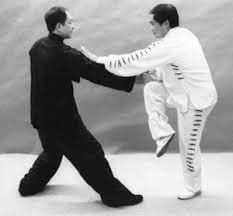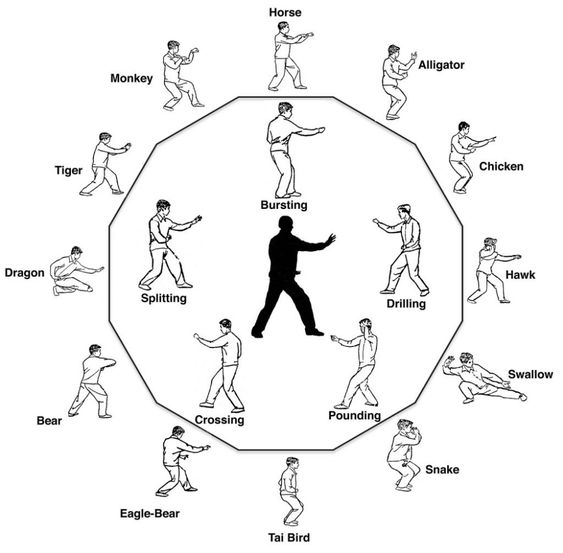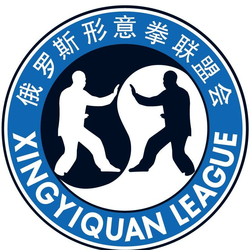
Xingyiquan (China)
- Name of sport (game): Xingyiquan
- Name in native language: 形意拳
- Place of practice (continent, state, nation):
China
- History:
Xingyiquan was created in imitation of the fighting techniques and spirit of twelve animals. One of the documents which are available to us contains a section which explains what Xingyiquan is. We would like to translate it here and make some comments. Hopefully this will give you a clear concept of Xingyiquan.
The history of the martial arts before the Qing Dynasty (1644 a.d.) is very vague because almost all of the Chinese martial artists were conservative and the styles were passed down secretly. It is the same with Xingyiquan. According to most of the available documents, the origin of Xingyiquan should probably be dated at least as far back as the Liang Dynasty (502-557 a.d.) at the Shaolin Temple. This is because, at this time, the Shaolin Temple was already imitating the movements and fighting spirit of five animals in their martial arts training. Later, during the Southern Song Dynasty (1127-1280 a.d.), it is believed that Zhang, San-Feng combined the concepts of Shaolin martial arts with his own understanding of Qi and created Taijiquan. In fact, many Xingyiquan practitioners believed that Xingyiquan originated at Wudang Mountain, the same as Taijiquan did.
Since the late Southern Song Dynasty, when the soldiers in Marshal Yue’s army were trained in Xingyiquan, the art has become very popular, and Marshal Yue is frequently credited with creating the art. However, since his martial arts originally came from the Shaolin Temple, many people trace Xingyiquan’s ancestry back to the Shaolin Temple.
Between the Song and the late Ming Dynasties, the history of Xingyiquan is again unclear. During the Qing Dynasty (1644-1912 a.d.), Xingyiquan became more popular because the mind of the Chinese people was more open, due in part to the more frequent contacts with Western culture. Consequently, its history during this period is better known.
Generally, it is believed that a martial artist named Ji, Ji-Ke(nicknamed Long-Feng) of Pu Zhou, who traveled and visited the well known masters in the mountains of Sichuan and Shanxi Provinces, obtained on Zhong Nan Mountain a secret book on Xingyiquan written by Marshal Yue. After he studied the art for some time, he passed it down to his disciple Cao, Ji-Wu, who in turn passed it down to Ji, Shou and Ma, Xue-Li. Ji, Shou later published Yue’s book and popularized the art even more.
There have been many famous Xingyiquan masters since then. From then (Qing Tong Zhi, 1862-1875 a.d.) until now, countless people have learned Xingyiquan. Here we can only name some of the best-known ones. There were Dai, Long-Bang and his brother Dai, Ling-Bang who learned from Ma, Xue-Li during the Qing Xian Feng period(1851-1862 a.d.). Then they passed the art down to Li, Luo-Neng. Li, Luo-Neng then passed it down to many of his students, the better-known ones being Song, Shi-Rong, Che, Yong-Hong, Liu, Qi-Lan, Guo, Yun-Shen, and Bo, Xi-Yuan. Among these five, Liu, Qi-Lan had many students such as his three sons, Liu, Jin-Tang, Liu, Dian-Chen, Liu, Rong-Tang, and students Li, Cun-Yi, Zhou, Ming-Tai, Zhang, Zhan-Kui, Zhao, Zhen-Biao, and Geng, Ji-Shan. Also, Guo, Yun-Shen passed down his arts to Liu, Yong-Qi, Li, Kui-Yuan, and Qian, Yan-Tang.
In the beginning of this century, when the Qing emperor fell and the republic was organized by Dr. Sun, Yat-Sen, the entire country entered a new era. As the nation gradually became more open-minded, the traditional secrets were more easily revealed to the public, and an enormous number of people took up Xingyiquan. For example, Li, Cun-Yi and Zhang, Zhan-Kui had a great many students, among them Li, Yun-Shan and Shang, Yun-Xiang. Shang, Yun-Xiang’s student Jin, Yun-Ting was a well known Xingyiquan promoter fifty years ago. Also, Li, Kui-Yuan’s student Sun, Lu-Tang was well-known as a Taijiquan, Xingyiquan, and Baguazhang master. Finally, Zheng, Huai-Xian learned from Sun, Lu-Tang and passed his arts to master Liang, Shou-Yu.
You can see that a chart of the generations of Xingyiquan masters would be very complicated. Keep in mind, also, that there are probably at least ten times as many people who also reached a high level of mastery, but are not well-known because they did not share their knowledge so generously with the public. This implies that the people mentioned were not necessarily the best Xingyiquan players of their time. A similar thing happened with Taijiquan. A great many people throughout the world know about Yang, Cheng-Fu and his style of Taijiquan, but fewer people know about his uncles and the generation older than his uncles whose techniques were said to be much higher than his.
Because the origin of Xingyiquan is so unclear, many martial artists would therefore credit Marshal Yue, Fei with its creation. There are several reasons for this. First, Marshal Yue, Fei was a Chinese hero and is respected by all Chinese. Second, Yue, Fei’s martial arts came from the Shaolin Temple, which is considered the origin of both the internal and external styles. Third, Yue, Fei’s ten theses on Xingyiquan demonstrate a very deep understanding of the art. Even though he may not be the creator, his theses have shown us the correct way to master the art. Fourth, Yue, Fei compiled and organized the Xingyiquan style into an effective martial system to train his soldiers. He is believed to be the first person to reveal the secrets of Xingyiquan to the public. Fifth, Yue, Fei was not only an expert in martial arts, he was also well known as a Qigong master. He is credited with creating the Eight Pieces of Brocade (Ba Duan Jin), which is a medical Qigong set for health, and the external martial style Yue Jia Ying Zhua (Yue Family’s Eagle Claw). It is believed that only a person who was an expert in both Chinese medicine and martial arts would be able to combine them to create these styles.by Dr. Yang, Jwing-Ming
Source: https://ymaa.com/articles/xingyiquan-part-1 - Description:
Styles of Xing Yi Quan
There are many styles of Xing Yi, and although training is similar in all styles, different styles have somewhat different emphasis and training methods.
There are considered to be three main branches of Xing Yi:
Shanxi Xing Yi
Hebei Xing Yi
Henan Xing Yi
To generalize the differences between the three, the Shanxi branch emphasizes a soft, flexible, hidden power (soft on the outside and hard inside), while Hebei styles are more direct and powerful (hard outside and soft inside). The Henan branch is sometimes called the “Muslim Style,” because it was handed down within the China’s Muslim community.
The style of Xing Yi passed on by Master Li Gui Chang to Tom Bisio and Internal Arts International comes from the Shanxi branch of Xing Yi Quan.Xing Yi Quan training is direct, simple and natural. The essence of the training method is contained in three inter-related practices:
Trinity Posture (San Ti Shi)
San Ti Shi is a form of standing meditation in which one senses deeply inside the body in order to cultivate an inner awareness of the mind and body, and gain insight into the subtle internal movements and transformations that are unfolding internally. A byproduct of this process is the development of inner stability, power, agility, and unification of body, mind and spirit.Four Method Breathing (Tu Na Si Ba)
Tu Na Si Ba is a unique blend of several classic Nei Gong methods that completely changes one’s internal body awareness. Tu Na Si Ba efficiently combines the essence of Southern (Nan) Shaolin Nei Gong, Marrow Washing Nei Gong (Xi Sui Jing), Breath Regulation (Tu Na) and the famous Muscle Tendon Change (Yi Jin Jing). Practice of Tu Na Si Ba builds fascial strength and integrative power, and strengthens the tendons, bones and joints. Tu Na Si Ba restores the body’s embryonic internal movement (true internal movement) that is often dormant in adultsSplitting Fist (Pi Quan)
The practice of Pi Quan is integral to Xing Yi Quan. Pi Quan is the root of all other movements and forms. Pi Quan acts as a counterpoint to San Ti Shi by training inner stillness within external movement, while carving away the non-essential to discover the inner core of one’s natural movement. Pi Quan develops integrated whole body power, linked to inner will and focused intention. Together Pi Quan and Tu Na Si Ba stimulate the Micro-Cosmic and Macro-Cosmic Orbits. These internal circulations of Qi, breath, essence and spirit actualize inner transformation and transcendence.Advanced Training Methods in Xing Yi Quan
Advanced Xing Yi training includes the Twelve Animal Fists, Xing Yi Quan Linking Forms, Xing Yi Spear (Qiang), Straight Sword (Jian), the Short Stick (Bian Gan), and many partner exercises.Twelve Animals
Dragon (Long Xing), Tiger (Hu Xing), Monkey (Hou Xing), Horse (Ma Xing), Alligator (Water Lizard – Tuo Xing), Rooster (Ji Xing), Swallow (Yan Xing), Sparrow Hawk (Yao Xing), Snake (She Xing). Tai Bird (Tai Xing), Eagle-Bear (Ying Xiong Xing), Bear (Xiong Xing). Each of the Twelve Animals expresses a different internal and external body configuration that are variations (or extensions) of Pi Quan and the Five Element Fists.
Xing Yi weapons include Xing Yi Spear (Qiang), Straight Sword (Jian), the Short Stick (Bian Gan).
The Sword and Spear help develop body awareness and internal connection. Both weapons train the Qi, intention and spirit, all of which must be extended out to the tip of the weapon. The spear and sword are also Daoist tools that cut through delusion and pierce through illusion. Training with these former battlefield weapons enhances internal awareness and refines internal movement.
The Short Stick (or cane or umbrella) offers a modern self-defense weapon.
Source: https://www.internalartsinternational.com/xing-yi-quan/ - Current status:
Practiced

- Contacts:
Chinese Internal Arts Association
Web: http://www.ciaa.org.uk/
Postal address:
Eva Koskuba
Lambs Farmhouse
Basingstoke Road
Swallowfield
Berks RG7 1PY
U.K.
telephone: 07905 514989 (+44 7905 514989)
e-mail:This email address is being protected from spambots. You need JavaScript enabled to view it. 
American Xingyiquan Baguazhang Institute
Web: https://www.xingyi-bagua.com/xingyi
Fb: https://www.facebook.com/AmericanXingyiBaguaAssociation/
Instagram: https://www.instagram.com/xingyibagua/?hl=en
Youtube: https://www.youtube.com/channel/UCAYH5FCdn6gpMik69O4GM3A
Xingyiquan League
E-mail:This email address is being protected from spambots. You need JavaScript enabled to view it.
Fb: https://www.facebook.com/people/Xingyiquan-League - Sources of information :
Books:
Li Jianqiu, The Art of Xingyiquan, 2023
Li Wen-bin, Shang Yun-xiang Style Xingyiquan, The Foundations And Subtleties Of Xingyiquan Training, North Atlantic Books, 2014
Shou-Yu Linag, Jwing-Ming Yang, Xingyiquan: Theory, Applications, Fighting Tactics and Spirit, YMAA Publication Center, 2002
Andrea Falk,Tianji Li,Deyin Li, Li Tianji's The Skill of Xingyiquan, Lulu press, 2021
Di Guoyong, On Xingyiquan: Hard Cover, Tgl Books, 2021
C S Tang, The Mysterious Power of Xingyi Quan: A Complete Guide to History, Weapons and Fighting Skills Paperback, Singing Dragon; Illustrated edition, 2013
Jwing-Ming Yang, XINGYI QUAN, Editorial Sirio; First Edition, 2004
Tom Bisio, Xing Yi Quan, Outskirts Press, 2019
Gong Zhon Franklin Fick, Authentic Xing Yi Quan, 2012
Lutang Sun, The Study of Xing Yi Quan, 2014
Jin Yunting, The Xingyi Boxing Manual, 2015
Lu Shengli, Combat Techniques of Taiji, Xingyi, and Bagua, Principles and Practices of Internal Martial Arts, 2006
Articles:
https://www.internalartsinternational.com/xing-yi-quan/
https://ymaa.com/articles/xingyiquan-part-1
https://what-when-how.com/martial-arts/xingyiquan-hsing-i-chuan-martial-arts/
https://sicknesskungfu.com/xingyiquan-theory/
https://www.yiquan.pl/xingyiquan/
https://www.martialtribes.com/mma-xin-yi2/
https://www.wudangdanpai.com/xingyiquan
https://www.usadojo.com/xingyiquan/
https://yamalaguna.com/portfolio-items/xing-yi-quan/
https://www.freedommartialart.com/japanese-arts/kung-fu/xing-yi-quan.html
https://www.wayofleastresistance.net/2010/02/cracking-xingyi-code.html
https://www.weihaikungfuacademy.com/blog/xingyiquan
https://www.ctmaa.com/content/Xing-Yi-Xingyi-Hsing-I-Hsing-Yi-Chicago-Internal-martial-arts-kung-fu/index.html
https://ensomartialarts.com/china/xing-yi-quan-history/Photos:
https://lotusneigong.com/project_category/xingyiquan/Videos:
https://www.youtube.com/watch?v=uP5OEjYVzKQ
https://www.youtube.com/watch?v=4ulJ1hBuIbk&t=1s
https://www.youtube.com/watch?v=HT4Yheu8okQ
https://www.youtube.com/watch?v=DMRsH-bbbBM
https://www.youtube.com/watch?v=resUgbo87qQ
https://www.youtube.com/watch?v=J7TR4WM6CuM
https://www.youtube.com/watch?v=lLpcKcZIU2c&t=1s
https://www.youtube.com/watch?v=1EiX4llQ5PU
https://www.youtube.com/watch?v=SwDgruwc8v0
https://www.youtube.com/watch?v=JQUofsZCTZA&t=1s
https://www.youtube.com/watch?v=POe3jqVvPZc
https://www.youtube.com/watch?v=2vHwuzbgMFA
https://www.youtube.com/watch?v=6-g2H8RIVC4
https://www.youtube.com/watch?v=StY5UOJzjSQ
https://www.youtube.com/watch?app=desktop&v=rElp16J6Si4The information contained in the article comes from the following sources:
https://ymaa.com/articles/xingyiquan-part-1
https://www.internalartsinternational.com/xing-yi-quan/Source of photos used in this article and gallery:
https://ymaa.com/articles/xingyiquan-part-1
https://what-when-how.com/martial-arts/xingyiquan-hsing-i-chuan-martial-arts/
https://www.yiquan.pl/xingyiquan/
https://www.martialtribes.com/mma-xin-yi2/
https://www.wudangdanpai.com/xingyiquan
https://www.weihaikungfuacademy.com/blog/xingyiquan
https://ensomartialarts.com/china/xing-yi-quan-history/ - Gallery:

